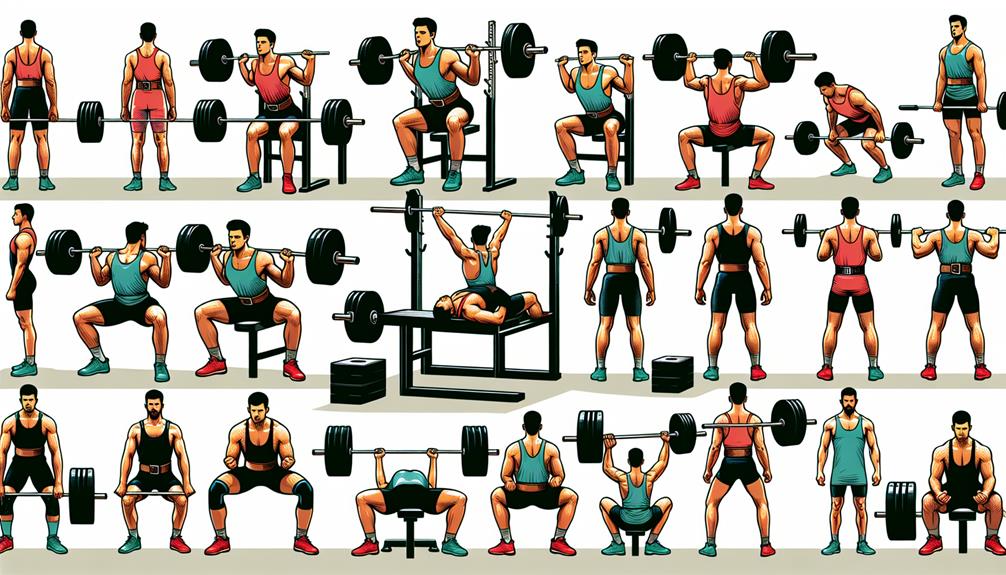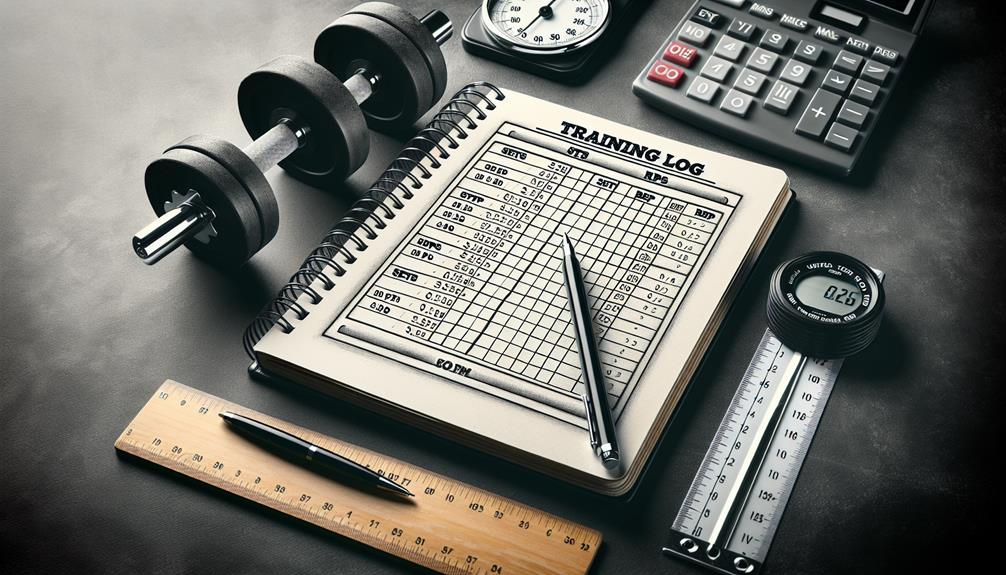Are you ready to take your powerlifting journey to the next level? If you've been wondering how to create an effective training program tailored to your specific needs and goals, you've come to the right place. In this guide, we will walk you through the step-by-step process of designing your own powerlifting program. Whether you're a beginner looking to build strength or an experienced lifter aiming to break personal records, this guide will provide you with the knowledge and tools you need to achieve success. So, let's dive in and unlock your full potential in the world of powerlifting.
Key Takeaways
- Setting clear and achievable goals is crucial for direction and motivation in powerlifting.
- Assessing current abilities helps in setting realistic short-term goals and identifying weaknesses to focus on during training.
- Choosing compound exercises that mimic competition movements and incorporating rest days for recovery are important in designing a training schedule.
- Tracking progress, making adjustments, and preventing injuries through proper form, rest, and recovery are essential for long-term progress in powerlifting.
Set Your Powerlifting Goals
To begin your powerlifting journey, it is crucial to set clear and achievable goals that will guide your training and propel you towards success. When it comes to powerlifting, setting goals is essential as they provide direction, motivation, and a sense of purpose throughout your journey. Whether you aspire to compete in a powerlifting competition or simply want to improve your strength and overall fitness, having specific goals in mind will help you stay focused and committed.
One important aspect of goal setting in powerlifting is mental preparation. Powerlifting competitions can be mentally demanding, and having a clear understanding of your goals can help you stay grounded and focused during the event. Visualizing success, practicing positive self-talk, and developing mental toughness are all strategies that can enhance your mental preparation for competitions.
When setting your powerlifting goals, it is important to make them realistic and achievable. Setting goals that are too ambitious or unrealistic can lead to frustration and disappointment. Begin by assessing your current abilities and setting short-term goals that will progressively lead you towards your long-term objectives. Remember to celebrate small victories along the way, as this will keep you motivated and reinforce your commitment to the sport.
Assess Your Current Strength and Fitness Level
Before diving into your powerlifting journey, it is crucial to assess your current strength and fitness level to establish a baseline and determine where you stand. This process will help you understand your strengths and weaknesses, allowing you to create a tailored program that addresses your specific needs. Here are some steps to assess your current strength and fitness level:
- Determine your weaknesses: Take the time to identify areas in which you may be lacking, whether it's upper body strength, core stability, or mobility. This will help you focus on improving these areas during your training.
- Establish a baseline: Test your current strength by performing exercises such as squats, deadlifts, and bench presses with proper form. This will give you a starting point to track your progress and set realistic goals.
- Assess your cardiovascular fitness: Determine your aerobic capacity by performing activities such as running, cycling, or rowing. This will help you understand your endurance level and guide your conditioning workouts.
- Evaluate your flexibility: Assess your range of motion and flexibility through exercises like the hamstring stretch, shoulder mobility drills, and hip mobility exercises. This will help you identify any imbalances or limitations that may affect your performance.
Choose the Right Powerlifting Exercises

When choosing the right powerlifting exercises, it is essential to select compound movements that target multiple muscle groups and mimic the movements performed in competition. Compound exercises, such as squats, deadlifts, and bench presses, engage various muscles simultaneously and help build overall strength and power. These exercises require proper technique to ensure optimal performance and reduce the risk of injury.
Proper technique is key when performing powerlifting exercises. It involves maintaining proper form, proper body alignment, and controlling the movement throughout the exercise. To learn and master the correct technique, it is advisable to seek guidance from a qualified powerlifting coach or trainer. They can provide valuable feedback and help you make the necessary adjustments to improve your form.
In addition to proper technique, equipment selection is another crucial aspect of choosing the right powerlifting exercises. Powerlifting requires specific equipment, such as a powerlifting barbell, squat rack, and bench press, to perform the exercises effectively and safely. It is important to invest in high-quality equipment that is durable and designed for heavy lifting. This will not only enhance your performance but also minimize the risk of accidents or equipment failure.
Design Your Training Schedule
Creating a well-designed training schedule is crucial for maximizing your powerlifting progress and achieving your strength and performance goals. By following a structured plan, you can ensure that you are consistently challenging your body and making progress towards your objectives. Here are some tips to help you design an effective training schedule:
- Prioritize compound exercises: Focus on compound lifts like squats, deadlifts, and bench presses. These exercises engage multiple muscle groups and are essential for building strength and power.
- Incorporate rest days: Rest is crucial for muscle recovery and growth. Make sure to include rest days in your training schedule to give your body time to repair and adapt to the demands of strength training.
- Gradually increase intensity: Gradually increase the weight or intensity of your workouts over time. This progressive overload principle is key to stimulating muscle growth and increasing strength.
- Plan for deload weeks: Every few weeks, plan a deload week where you decrease the volume or intensity of your workouts. This allows your body to recover and prevent overtraining.
Track Your Progress and Make Adjustments

To continue maximizing your powerlifting progress and achieving your strength and performance goals, it is important to track your progress and make necessary adjustments along the way. Tracking your progress allows you to see how far you've come and identify areas where you can improve. Additionally, making adjustments to your program ensures that you continue to challenge yourself and avoid hitting a plateau.
One effective way to track your progress is by keeping a training journal. In this journal, you can record details such as the exercises you performed, the weights lifted, and the number of repetitions completed. By tracking these variables, you can monitor your progress over time and identify any patterns or trends. This will help you make informed decisions when it comes to adjusting your training program.
Another important aspect of tracking your progress is paying attention to your rest and recovery. Rest days are not to be overlooked, as they play a crucial role in your overall progress. By giving your body enough time to recover, you are allowing your muscles to repair and grow stronger. Ignoring rest and recovery can lead to overtraining and increase the risk of injuries.
Speaking of injuries, it is essential to take steps to prevent them while powerlifting. One way to do this is by ensuring proper form and technique. Performing exercises with improper form can put unnecessary stress on your joints and muscles, increasing the likelihood of injury. It is also crucial to listen to your body and avoid pushing yourself too hard. Gradually increasing the intensity and volume of your workouts will reduce the risk of overexertion.
Incorporating a variety of exercises into your training program can also help prevent injuries. By targeting different muscle groups and using different movement patterns, you can avoid overloading a specific area and reduce the risk of overuse injuries. Additionally, incorporating exercises that focus on stability and mobility can improve your overall strength and reduce the risk of imbalances or compensations.
To summarize, tracking your progress and making necessary adjustments are vital for maximizing your powerlifting progress. By keeping a training journal, paying attention to rest and recovery, and taking steps to prevent injuries, you can continue progressing towards your goals while staying safe and injury-free.
| Importance of Rest and Recovery | How to Prevent Injuries while Powerlifting | Incorporating Variety into Your Training |
|---|---|---|
| Gives muscles time to repair and grow stronger | Ensure proper form and technique | Target different muscle groups and movement patterns |
| Reduces the risk of overtraining | Listen to your body and avoid pushing too hard | Focus on stability and mobility |
| Increases overall performance and prevents burnout | Gradually increase intensity and volume | Avoid overloading specific areas |
| Improves mental focus and reduces stress | Incorporate rest days into your schedule | Reduce the risk of overuse injuries |
| Enhances muscle growth and strength gains | Warm up properly before lifting | Balance strength and stability exercises |
Frequently Asked Questions
How Can I Prevent Injuries While Powerlifting?
To prevent injuries while powerlifting, focus on injury prevention techniques. Incorporate proper warm-up and cool-down routines, maintain good form and technique, listen to your body's signals, and gradually increase weight and intensity over time.
What Should I Eat Before and After a Powerlifting Session?
Before and after a powerlifting session, it's crucial to fuel your body with the right nutrition. Pre-workout, focus on carbs for energy. Post-workout, prioritize protein for muscle recovery and growth. Proper fueling is key for optimal performance in powerlifting.
How Long Should I Rest Between Sets and Exercises?
To optimize your powerlifting gains, it's crucial to find the right balance between rest intervals and exercise duration. By giving your muscles ample time to recover, you'll be able to push harder and achieve the liberation you desire.
Can I Incorporate Other Forms of Exercise, Such as Cardio or Yoga, Into My Powerlifting Program?
Yes, you can definitely incorporate other forms of exercise, such as cardio or yoga, into your powerlifting program. This will provide you with cardiovascular benefits and help improve your flexibility.
How Do I Choose the Right Powerlifting Equipment, Such as Belts, Wrist Wraps, and Knee Sleeves?
To choose the right powerlifting equipment, consider your specific needs and goals. Belts provide support for your core, wrist wraps offer stability for heavy lifts, and knee sleeves protect your joints. Prioritize injury prevention techniques and consult with experienced lifters for guidance.
Conclusion
Congratulations! You've reached the end of this step-by-step guide on creating your powerlifting program. Now, armed with knowledge and expertise, you can embark on your journey towards becoming a powerlifting champion. Remember, setting goals, assessing your current level, choosing the right exercises, designing a schedule, and tracking your progress are all key ingredients to success. So go ahead, lift those weights, and let the irony of your strength make others marvel at your power!














